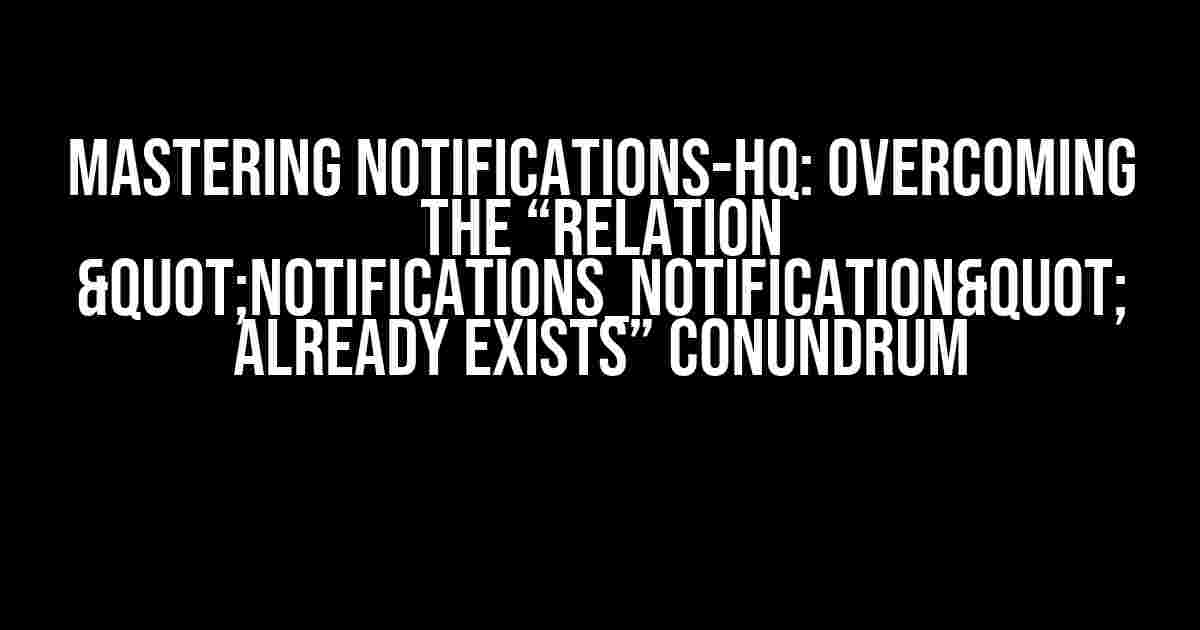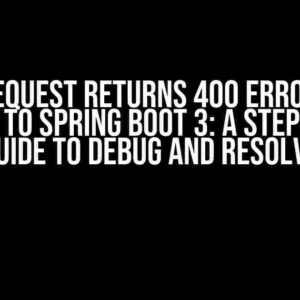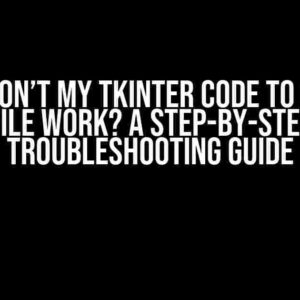Welcome to the world of Notifications-HQ, where timely and efficient communication is just a implementation away! However, we’ve all been there – stuck on the same error message, wondering what went wrong. In this comprehensive guide, we’ll delve into the mystery of the “Relation "notifications_notification" already exists” error and provide you with the expertise to overcome it with ease.
The Mystery Unfolds: Understanding the Error
Before we dive into the solution, let’s take a step back and understand the root cause of the problem. The error message “Relation "notifications_notification" already exists” typically occurs when you’re trying to implement Notifications-HQ in your application, and it’s complaining about a relation that already exists in the database.
This error can be triggered by a variety of factors, including:
- Inconsistent database schema
- Incorrect migration orders
- Overlapping relation definitions
- Database upgrades or rollbacks gone wrong
Gathering the Clues: Identifying the Culprit
To resolve the issue, we need to identify the source of the problem. Let’s take a closer look at the error message and break it down into its constituent parts:
Relation "notifications_notification" already existsFrom this, we can deduce that:
- The error is related to the “notifications_notification” relation
- This relation already exists in the database
- The implementation is trying to create a new relation with the same name
The Solution Unveiled: Step-by-Step Instructions
Now that we’ve identified the problem, it’s time to get our hands dirty and implement the solution. Follow these step-by-step instructions to overcome the “Relation "notifications_notification" already exists” error:
Step 1: Inspect Your Database Schema
Take a closer look at your database schema to ensure that there are no existing relations with the same name. You can do this using the following SQL command:
SELECT * FROM information_schema.table_constraints WHERE table_name = 'notifications' AND constraint_name = 'notifications_notification';If you find an existing relation, make a note of it. We’ll come back to this later.
Step 2: Review Your Migration Orders
Check your migration orders to ensure that they’re in the correct sequence. If you’re using a tool like Alembic, review your migration scripts to ensure that they’re not attempting to create the same relation multiple times.
Here’s an example of how you can check your migration orders in Alembic:
alembic history --verboseStep 3: Resolve Overlapping Relation Definitions
Inspect your model definitions to identify any overlapping relation definitions. If you find any duplicates, merge them into a single definition or rename one of the relations to avoid conflicts.
For example, if you have two models with identical relation definitions:
class Notification(Base):
__tablename__ = 'notifications'
id = Column(Integer, primary_key=True)
notification_type = Column(String)
__table_args__ = (
ForeignKeyConstraint(['notification_type'], ['notification_types.id']),
)
class NotificationType(Base):
__tablename__ = 'notification_types'
id = Column(Integer, primary_key=True)
name = Column(String)
__table_args__ = (
ForeignKeyConstraint(['id'], ['notifications.notification_type']),
)Merge them into a single definition:
class Notification(Base):
__tablename__ = 'notifications'
id = Column(Integer, primary_key=True)
notification_type_id = Column(Integer, ForeignKey('notification_types.id'))
notification_type = relationship("NotificationType", backref="notifications")
class NotificationType(Base):
__tablename__ = 'notification_types'
id = Column(Integer, primary_key=True)
name = Column(String)Step 4: Update Your Database Schema
Once you’ve resolved the issues above, update your database schema to reflect the changes. You can do this by running the following command:
alembic upgrade headThis will apply the necessary changes to your database schema, resolving the “Relation "notifications_notification" already exists” error.
Step 5: Verify the Solution
After updating your database schema, verify that the error has been resolved by attempting to implement Notifications-HQ again. If you encounter any further issues, revisit the steps above and ensure that you’ve followed them correctly.
Conclusion: Mastering Notifications-HQ
In this comprehensive guide, we’ve demystified the “Relation "notifications_notification" already exists” error and provided you with a step-by-step solution to overcome it. By following these instructions, you’ll be able to successfully implement Notifications-HQ in your application, ensuring timely and efficient communication with your users.
Remember, mastering Notifications-HQ requires attention to detail, a solid understanding of database schema, and a dash of creativity. With this guide, you’re now equipped to tackle even the most complex implementation challenges. Happy coding!
| Common Error Messages | Causes | Solutions |
|---|---|---|
| Relation “notifications_notification” already exists | Inconsistent database schema, incorrect migration orders, overlapping relation definitions, database upgrades or rollbacks gone wrong | Inspect database schema, review migration orders, resolve overlapping relation definitions, update database schema |
| Cannot create relation “notifications_notification” because it already exists | Existing relation with the same name, incorrect database schema | Check database schema, rename or merge existing relation, update database schema |
By following this guide, you’ll be able to overcome common errors and implement Notifications-HQ with confidence. Remember to stay curious, keep learning, and happy coding!
Frequently Asked Question
Get the solutions to your “Notifications-HQ” implementation woes!
What is the “relation ‘notifications_notification’ already exists” error, and how do I fix it?
This error occurs when you’re trying to create a new relation with the same name as an existing one. To resolve this, simply drop the existing relation and then re-run the migration to create the new one. You can do this by running the command `npx sequelize db:migrate:undo` and then `npx sequelize db:migrate` again.
How do I configure Notifications-HQ to work with my existing database?
To configure Notifications-HQ with your existing database, you’ll need to update the `sequelize` config to point to your database. Create a new file called `sequelize.config.js` and add your database credentials. Then, update the `database` field in your `Notifications-HQ` config to point to this new file. Finally, run the migration to create the required tables.
What if I’m using a different database manager, like TypeORM or MongoDB?
Notifications-HQ currently only supports Sequelize, but you can use adapters to connect to other databases. For example, you can use `@sequelize/typeorm` to connect to TypeORM or `mongoose` to connect to MongoDB. You’ll need to write custom adapters to integrate Notifications-HQ with your chosen database manager.
How do I handle notification sending and processing in a scalable way?
To handle notification sending and processing at scale, consider using a message broker like RabbitMQ or Apache Kafka to queue notifications. This allows you to process notifications asynchronously and handle high volumes of traffic. You can also use workers or job queues to process notifications in the background.
What if I need custom notification logic or workflows?
Notifications-HQ provides a flexible architecture for custom notification logic and workflows. You can extend the existing notification types or create new ones using plugins. You can also write custom business logic using Node.js and integrate it with Notifications-HQ using its APIs and event-driven architecture.



